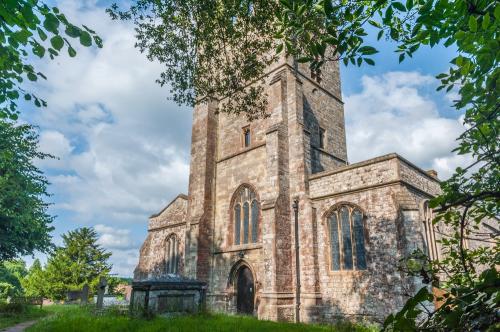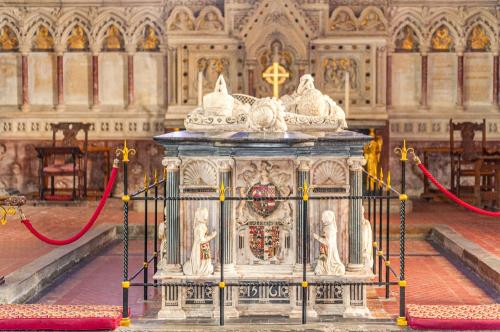
The parish church of St Mary Magdalene, Cobham, Kent, is home to a superb collection of memorial brasses, most of them to members of the De Cobham family. There are 20 brasses in total, with 15 arrayed in a continuous pavement in front of the communion rail in the chancel. Together, the Cobham brasses form perhaps the most impressive collection in the UK and have been called the finest in the entire world.
History
There was a church at Cobham before the Norman Conquest, but the earliest record comes from 1115. The oldest part of the present building is the chancel, which dates to 1220, when it was built to serve as a chapel for a college of priests established at nearby Cobham College.
The nave was added this 13th-century chapel around 1365. The nave was followed by the west tower and the westernmost bays of the aisles. The tower and aisles are thought to be the work of perhaps the most famous of medieval masons, Henry Yevele, the royal Master Mason. Yevele is best known for the naves of Westminster Abbey and Canterbury Cathedral.
The chancel arch is a Victorian restoration of the medieval original. The Victorian work was overseen by Sir George Gilbert Scott, one of the most famous and influential architects of 19th-century England.

Historical Highlights
The De Cobham brasses are the undoubted highlight of a visit to St Mary's. It is extraordinary that they have survived largely intact, given the depredations of the iconoclasts during the English Reformation. But are they intact? A diarist writing in the 18th century said that he saw them stored willy-nilly in an old chest. A later writer claimed that workmen restoring the church were stealing brasses.
It seems likely that the brasses were hidden at the time of the Civil War. They were returned in the early 19th century and re-laid in 1837, then taken up and re-laid again in the 1860s.

The Cobham Brasses
As mentioned, there are 20 brasses in total, with dates ranging from 1299 to 1529.
The most important is that of Sir John de Cobham (d 1407), who founded Cobham College. Sir John was responsible for rebuilding the nave, adding the aisles, raising the church roof, and building the porch with its parvise, or priest's chamber, above.
Sir John provided the money for the imposing tower and gave generously to the church. His brass describes him as 'the founder of this place' which, though perhaps not technically true, hints at how profoundly he affected the building we see today. In memory of this influence, his brass carries a model of the church in its hands.

Then there is the brass of Joan de Cobham (d 1298). This is the earliest memorial brass in England to depict a woman and was crafted sometime between 1305-1310, long after Joan de Cobham's death. This is also one of the earliest brasses to use a canopied design.
Joan was the wife of John 'the younger' Lord Cobham, whose brass has now been lost, and the granddaughter of the first Lord John. Joan merited her own brass because she was born into the wealthy Septvans family and was therefore of equal or even superior status to her husband.
This exceptional brass is estimated to have cost in the neighbourhood of ten pounds when it was made, a veritable fortune for the time. It shows Joan wearing a full-length gown with demi-sleeves, over a kirtle. Her head is protected by a veil and a wimple covers her chin.

Just to be confusing, there is a later brass to a different Lady Joan Cobham, who died in 1433. Other Cobhams commemorated include Sir Thomas Cobham (1367), Lady Maude Cobham (1370), Lady Margaret Cobham (1385), Margaret, Lady Cobham (1395), Rauf de Cobham (d 1402), Sir Reginald Baybrooke (1405), and Sir Nicholas Hawkberk (d 1407).
Several Masters of Cobham College are remembered with brasses, including William Tanner (d 1418), the first Master, John Gladwyn (1440), and John Sprotte, who in 1498. Other brasses are those of Sir John and Lady Brooke (1506), Sir Thomas Brooke and his wife (1529), George, Lord Cobham (1558), and John Gerrye (1447).

Tilting Helmets
Hanging in the chancel are four tilting helmets. These are copies, and the originals are stored in the Royal Armouries in Leeds.
Most tilting helmets are purely ceremonial and were never intended to be worn in combat; they were designed to be carried in the funeral procession and then hung ion the church, near their owner's grave. That is true of three of the Cobham helmets, but one, made around 1380, was designed for jousting and then later altered to become a ceremonial titling helmet. The two oldest of the helmets date to around 1380, while the newest dates to 1558.
In the south aisle wall is a blocked doorway. This was used by priests from Cobham College to enter the church. Here they would say Mass for the souls of the college founder and his family.
In the chancel is a single medieval choir stall, still retaining its carved misericord. Above the stall is a section of Roman tile incorporated into the chancel wall.

The Brooke Tomb
This exceptional marble and alabaster tomb commemorates Sir George Brooke, 8th Lord Cobham, and his wife, Lady Anne. The couple died within 30 days of each other in 1558. Sir George is shown in his Garter robes, and he wears a garter on his left knee. He served under Queen Mary and was the last English Governor of Calais.
The tomb is an outstanding example of Elizabethan craftsmanship and features life-sized effigies of the couple, with figures of their ten sons and four daughters arranged around the plinth.
The communion table is topped by a Purbeck marble slab, still bearing its consecration crosses. When the slab was taken up as part of renovations in 1860, workmen discovered an earthenware vessel holding bones hidden beneath it. These are thought to have been secreted during the religious turmoil of the Reformation. The slab was returned to its original location in 1949 as a tribute to Sir Herbert Baker, the architect, who lived at nearby Owletts house, now under the care of the National Trust.

You can still see the remains of a doorway that led up a set of stairs to the medieval rood loft, now long since removed. When the rood stair was opened in 1860, a cache of hidden sculptures was found. These are thought to have formed part of the medieval reredos, and are now on display in the former vestry, which serves as a small museum.
In a vault beneath the chancel lie the Earls of Darnley and their families.
Visiting
Cobham's parish church is a delight, full of historical interest, and well worth visiting. The display of brasses alone makes a visit worthwhile. As far as we can determine, the church is open daily to visitors and it was open when we visited.
About Cobham, St Mary Magdalene Church
Address: The Street,
Cobham,
Kent,
England, DA12 3DB
Attraction Type: Historic Church
Location: On The Street, in the heart of Cobham village. There is car parking behind the Leather Bottle inn.
Website: Cobham, St Mary Magdalene Church
Location
map
OS: TQ669683
Photo Credit: David Ross and Britain Express
HERITAGE
 We've 'tagged' this attraction information to help you find related historic attractions and learn more about major time periods mentioned.
We've 'tagged' this attraction information to help you find related historic attractions and learn more about major time periods mentioned.
Historic Time Periods:
Find other attractions tagged with:
brass (Historical Reference) - Gilbert Scott (Person) - Medieval (Time Period) -
NEARBY HISTORIC ATTRACTIONS
Heritage Rated from 1- 5 (low to exceptional) on historic interest
Cobham College - 0 miles (Historic Building) ![]()
Owletts - 0.1 miles (Historic Building) ![]()
Cobham Hall - 0.9 miles (Historic House) ![]()
Cobham Mausoleum - 1.5 miles (Historic Building) ![]()
Milton Chantry - 3.4 miles (Historic Building) ![]()
Temple Manor - 3.9 miles (Historic Building) ![]()
Paddlesworth, St Benedict's Church - 4 miles (Historic Church) ![]()
Tilbury Fort - 4.5 miles (Historic Building) ![]()
Nearest Holiday Cottages to Cobham, St Mary Magdalene Church:
More self catering near Cobham, St Mary Magdalene Church












